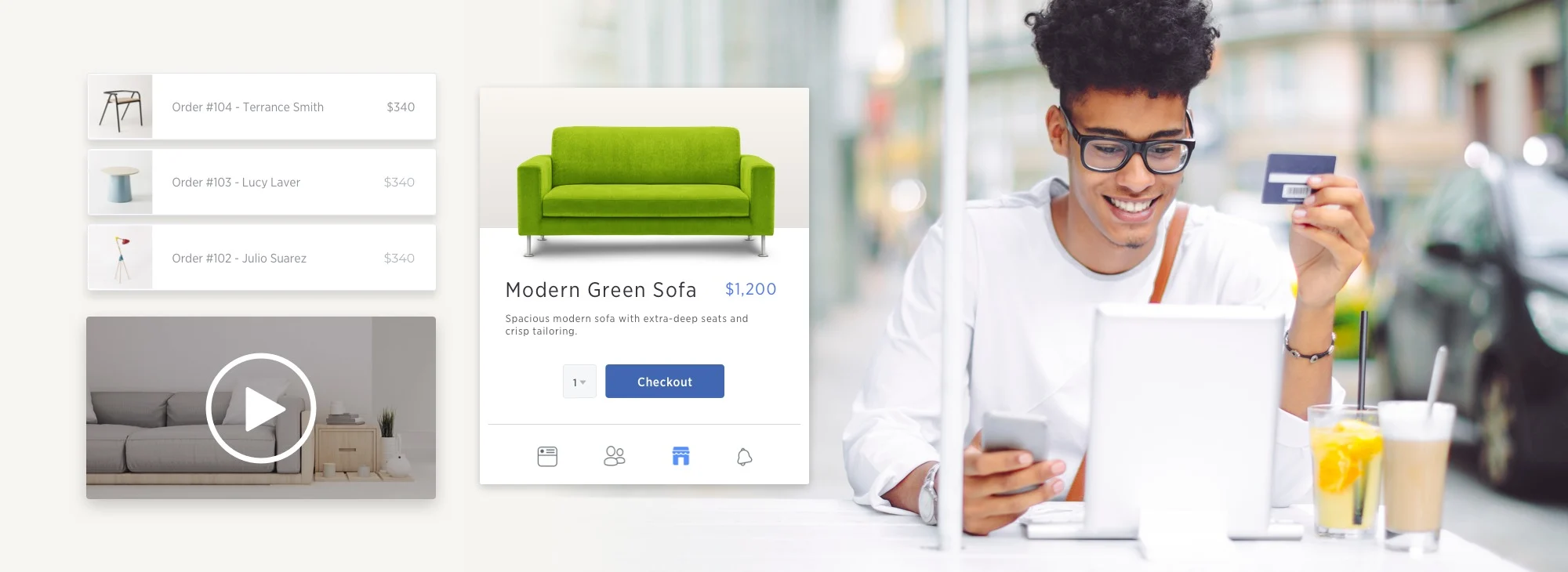What the History of Retail Can Teach Us About Achieving Ecommerce Success


What the History of Retail Can Teach Us About Achieving Ecommerce Success
Get The Print Version
Tired of scrolling? Download a PDF version for easier offline reading and sharing with coworkers.
A link to download the PDF will arrive in your inbox shortly.
I’ve been a student of retailing since I was 12.
Actually, I should say I’ve been in love with retail since I was 12.
I’ve worked for and started several retail companies since then. I’ve:
Covered retail stocks on Wall Street.
Worked for two big department store companies.
Founded Bookstop (which was acquired by Barnes and Noble).
Founded Hoovers.com (which was acquired by Dun and Bradstreet).
Served on the Board of Directors of Whole Foods Market, among others.
I’ve always loved the history of retail as well.
In this blog post, we’ll dive into some of the important moments and companies in retail history—especially as they relate to strategies for ecommerce success.
Watch or Read: You Choose
This article is a wrap-up of a longer interview BigCommerce did with Gary Hoover for the Make It Big Conference 2018. See the full video interview here, or continue reading below.
A Brief History of Non-Store Selling
Retailing that occurs anywhere outsideof brick-and-mortar stores was called “non-store selling.”
Non-store selling includes vending machines, door-to-door sales, mail order sales, and now online selling.
Historically, the biggest of those (by far) was mail order, although things like selling vacuum cleaners and cosmetics (Avon) door-to-door and Tupperware parties were popular as well.
So, while online selling is a relatively new concept, non-store selling has always been around.
Sears, Roebuck once had the greatest non-store selling operation in the world.
The Sears catalog, which was a powerhouse for most of the twentieth century, ceased publication the year before Amazon started.
The Sears Roebuck / Amazon Paradox
If you look at what Amazon has accomplished, their evolution has a tremendous amount of parallels with Sears Roebuck.
Sears went from selling exclusively through their mail-order catalog in the early to mid-1920s to opening stores and having over half of their sales come from stores by 1931.
Sears had a lot of debates about whether to charge higher or lower prices in their stores, because stores are more expensive in many ways.
Amazon will be having a lot of the same debates as they continue to move into physical retailing.
Whether it’s Harry & David, Pottery Barn, or Macy’s, the printed catalog business is still much bigger than most people realize.
Some of the best omnichannel marketers still aggressively use printed mail order catalogs in addition to physical stores and online commerce.
For the first 50+ years of non-store selling, the share of total retail sales occurring outside of stores didn’t change very much.
Between vending machines, door-to-door sales, mail order sales, and online sales, non-store selling only comprised about 4-5% of total U.S. retailing from the 1950s until around 2005.
Today, between 9 and 10% of total U.S. retail sales are online while around 90% still take place in physical stores.
Of course, it’s no secret that online sellers are steadily taking market share.
In fact, eMarketer predicts that online sales will be 14.6% of total retail sales by 2020, so ecommerce is clearly increasing very quickly.
My own prediction is that they won’t reach that level until the late 2020s.
Making the Move From Online to Offline
I’m a big believer in retailers being omnichannel, which is using every online and offline method possible to attract, engage, and convert customers.
Almost all of the big retailers that traditionally operated physical stores are now omnichannel – Walmart and Home Depot are great examples.
Amazon is becoming omnichannel with their acquisition of Whole Foods and their opening of their own brick-and-mortar bookstores.
But many small online-only retailers want to expand into offline channels as well.
And while making this move can be very lucrative, there are many pitfalls to consider.
It’s really easy to underestimate how difficult physical retailing is.
When you look at a company like Walmart that has over 3,000 Walmart Supercenters that each carry around 120,000 different items, the challenges of coordinating a retail operation on that scale are massive.
Amazon has around 140 fulfillment centers to manage, which is a piece of cake compared to what Walmart does every day of the week.
The biggest retail chain on Earth in terms of number of locations is 7-Eleven: they have about 63,000 stores.
It’s staggering to think about what it takes to coordinate all of those stores along with all of their products and employees.
When you walk into a 7-Eleven, you see that they have the same signs, the same merchandise, the same Doritos display, etc. It’s like magic!
Having been in retailing for so long, I know how incredibly difficult it is to pull this off.
Providing a consistent, seamless, and exceptional customer experience is anything but easy.
Real estate selection is another factor to consider.
There’s a science and an art to retail real estate that is really critical to survival.
You have to ask questions like:
Am I on the right side of the street?
Do I want to attract customers that are on their way to work or on their way home from work?
How’s my ingress and egress?
If you’re next to a big supermarket, do you have to go out and get on the frontage road and then come back into your center or is there a cut-through?
Physical retailers also underestimate how big their sign needs to be.
After word-of-mouth, a retailer’s sign is their most important form of advertising so that’s yet another thing you have to get right if you make the move from online to offline.
Understanding Your Customers
Sam Walton always said that if you’re having trouble making a decision as a retail executive, just go to the stores because customers have all the answers.
And that’s one of the reasons I love retailing.
I get to examine customers interacting with the brand in real-time, up close and personal.
Even as the CEO of Bookstop, I felt like I wasn’t truly doing my job if I wasn’t regularly engaging with customers, watching their body language, watching which products interested them, and basically just observing how they experienced the store.
You can’t spend too much time getting to know your customers or understand enough about them.
For example:
Are they men or women?
What’s their age bracket?
Do they have children?
What cities do they live in?
Where else do they shop?
What do they wear?
Which restaurants do they go to?
Where do they go on vacation?
What are their interests?
You simply can’t know too much, and it’s all about putting yourself in their shoes.
If you can get inside their heads, you have a huge competitive advantage.
There are many different methods you can use to get to know your customers, including:
Special promotional events and gatherings.
Having a booth at the state fair or festival.
Creating a pop-up store.
Finding a way to embed your product in a physical store.
Conducting focus groups and surveys.
Going to shopping malls, airports, museums, or even Walmart to observe them.
Humanizing Ecommerce
When we think about ecommerce, it’s easy to underestimate the power of humans and overestimate the power of computers.
If you can figure out how to humanize your customers’ shopping experience on your ecommerce site, you’ll have a big advantage over the vast majority of your competitors.
You can humanize your business by doing simple things like having an About page that tells your company’s story and includes pictures of your executive team.
Telling the story of your company and products using videos is especially effective at humanizing your brand.
For example, a manufacturer of specialty foods called Lancaster Colony has purchased several small companies over the years.
Their common characteristic is that their websites showcase a human story—such as videos showing the founder of the company cooking her brand’s food in her kitchen.
Another example of humanizing an ecommerce site was Richard Branson’s Virgin Music stores before the virtual collapse of the record store industry.
Instead of having a complaint or contact page, the site said, “Get me a manager.”
He was trying to emulate the store experience to some extent and to have a sense of humor, like Branson does in all of his businesses.
Amazon does a wonderful job of personalizing the customer experience by reminding you what products you’ve previously viewed and purchased, as well as by keeping you informed of your order status through every stage of the fulfillment and shipping process.
Yet another example is Dollar Shave Club, which did an amazing job of creating a viral online ad campaign with humorous videos that humanized the brand and connected with people.
These are just a few of the little things you can do in ecommerce to create a more human component to help build a relationship with your customers.
Final Thoughts
The best way to learn retailing is to study the lives of the great retailers we’ve had throughout history.
The book The Great Merchants is a great place to read about those people and their businesses.
When you understand the history, you can avoid making unnecessary mistakes as well as learn the innovative insights they had to take their businesses to new heights.
And remember: If you don’t innovate in your retail business, you won’t be around for very long.
But before you consider innovating, make sure you get the basics of retailing right.
If you’re considering taking your online store into offline channels, take it slow.
Figure out ways to put your toe in the water.
Whether that’s opening pop-up stores, attending state fairs, or hosting an event, get to know your customers so you can build relationships with them.
Most importantly, I don’t think you can be truly successful at ecommerce if you don’t meet your customers and look them in the eye.
It will help you understand what makes them tick and enable you to create a more human shopping experience on your ecommerce site.

Gary Hoover has served as a securities analyst for Citibank on Wall Street, worked as a buyer for Federated Department Stores, and headed up acquisitions and strategic planning for the Macys Department Stores Company. He founded BOOKSTOP which he would later sell to Barnes & Nobles where it became a cornerstone for their industry-dominating superstore chain. He founded Hoovers.com, the world’s largest Internet-based provider of information about enterprises., covered over 40,000 companies around the world. Gary served as Entrepreneur-in-Residence at the Herb Kelleher Center for Entrepreneurship at the McCombs School of Business at the University of Texas in Austin. He has consulted, spoken to conferences, and worked to encourage entrepreneurial thinking on every continent and in every industry, for profit and not for profit.


